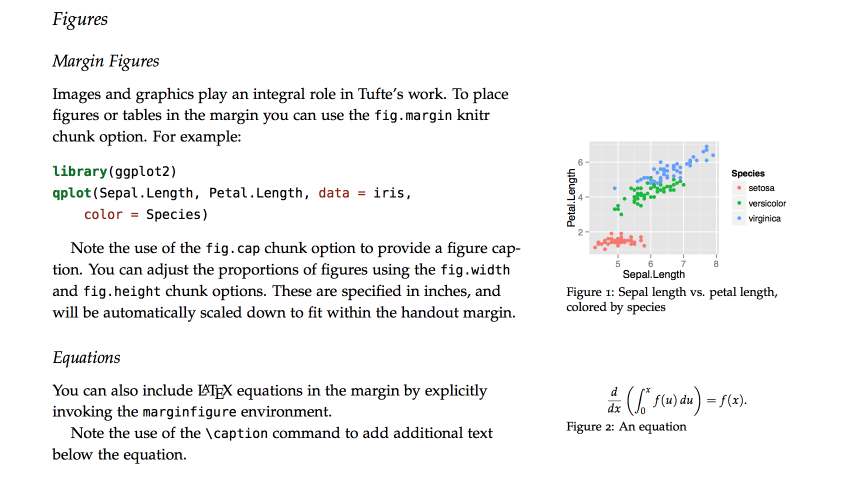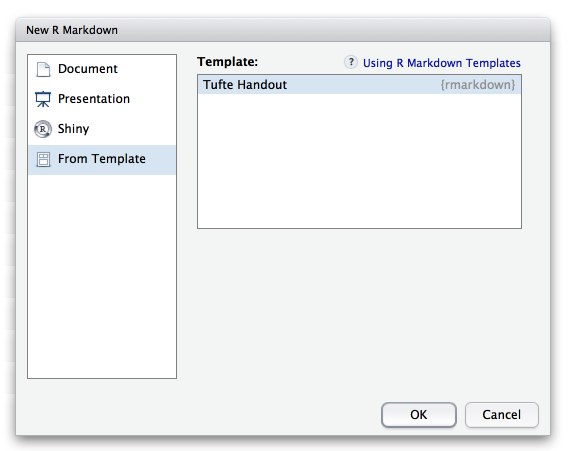Tufte Handouts
Overview
Tufte Handouts are documents formatted in the style that Edward Tufte uses in his books and handouts. Tufte’s style is known for its extensive use of sidenotes, tight integration of graphics with text, and well-set typography:

Tufte Handouts can create either HTML or PDF output. You can see a full examples documents produced with the Tufte Handout template here:
These documents serve not only as examples but also documention of the various techniques used for formatting footnotes, sidenotes, figures, tables, etc.
Getting Started
Installation
Note that the tufte_handout format is not contained within the rmarkdown package but rather in a separate tufte package. You can use this format in R Markdown documents by installing this package as follows:
install.packages("tufte")Creating a Handout
You can create a new Tufte Handout from within the RStudio New R Markdown dialog:

If you are not using RStudio then you can use the rmarkdown::draft function as follows:
library(rmarkdown)
draft("my_handout.Rmd", template = "tufte_html", package = "tufte")The newly created document will include the various HTML and LaTeX based tufte handout formats as shown here:
---
title: "Tufte Handout"
subtitle: "An implementation in R Markdown"
author: "JJ Allaire and Yihui Xie"
date: "2018-12-08"
output:
tufte::tufte_html: default
tufte::tufte_handout:
citation_package: natbib
latex_engine: xelatex
tufte::tufte_book:
citation_package: natbib
latex_engine: xelatex
bibliography: skeleton.bib
link-citations: yes
---Figure Options
There are a number of options that affect the output of figures within PD documents:
fig_widthandfig_heightcan be used to control the default figure width and height (6 x 4.5 is used by default)fig_cropcontrols whether the the pdfcrop utility (if available) is automatically applied to pdf figures (this is true by default).
For example:
---
title: "Tufte Handout"
output:
tufte::tufte_handout:
fig_width: 4
fig_height: 4
---Syntax Highlighting
The highlight option specifies the syntax highlighting style. Supported styles include “default”, “tango”, “pygments”, “kate”, “monochrome”, “espresso”, “zenburn”, and “haddock” (specify null to prevent syntax highlighting):
For example:
---
title: "Tufte Handout"
output:
tufte::tufte_handout:
highlight: tango
---Advanced Customization
Intermediate TeX
R Markdown documents are converted to PDF by first converting to a TeX file and then calling the LaTeX engine to convert to PDF. By default this TeX file is removed, however if you want to keep it (e.g. for an article submission) you can specify the keep_tex option. For example:
---
title: "Tufte Handout"
output:
tufte::tufte_handout:
keep_tex: true
---Includes
You can do more advanced customization of PDF output by including additional LaTeX directives and/or content or by replacing the core pandoc template entirely. To include content in the document header or before/after the document body you use the includes option as follows:
---
title: "Tufte Handout"
output:
tufte::tufte_handout:
includes:
in_header: header.tex
before_body: doc_prefix.tex
after_body: doc_suffix.tex
---Pandoc Arguments
If there are pandoc features you want to use that lack equivilants in the YAML options described above you can still use them by passing custom pandoc_args. For example:
---
title: "Tufte Handout"
output:
tufte::tufte_handout:
pandoc_args: [
"--no-tex-ligatures"
]
---Documentation on all available pandoc arguments can be found in the pandoc user guide.